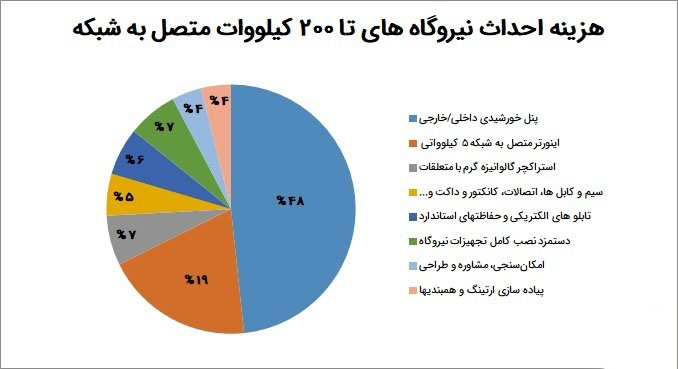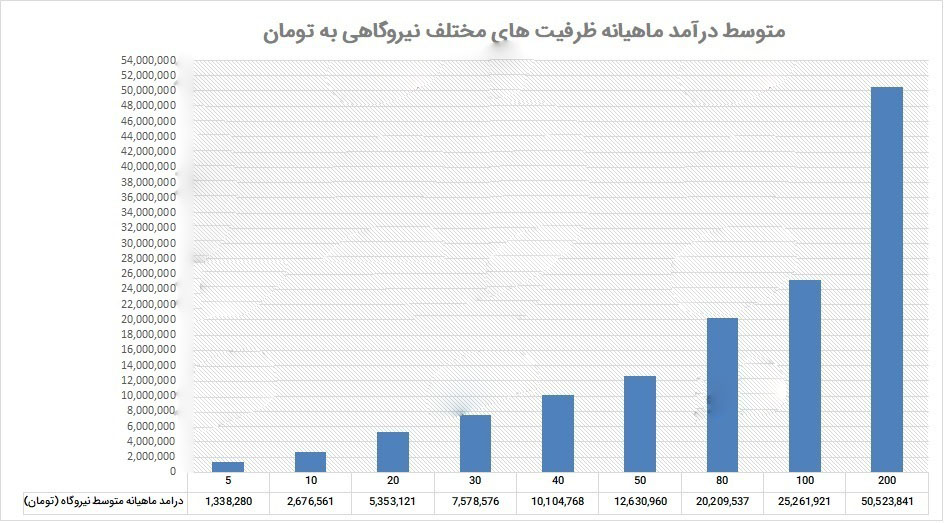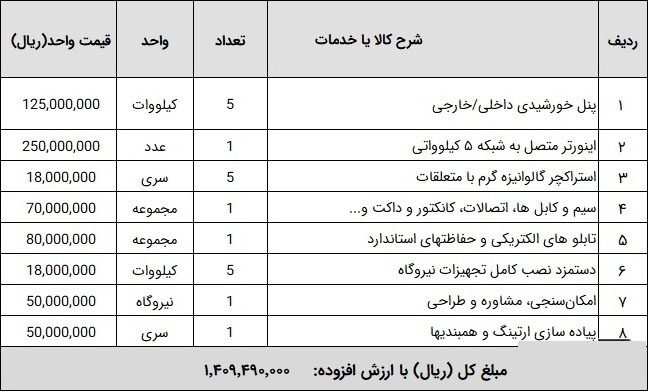An analysis of the cost-income of solar power plants with new prices/ poor economic justification and solar industry death

- news
- 0
A cost-benefit analysis of solar power plants with new prices/poor economic justification and the death of the solar industry
The current prices considering that the cost of building each kilowatt of solar power plants connected to the on-grid branching network has reached more than 27 million tomans cannot create an incentive to invest in this field. The electricity of small solar power plants is determined to be less than that of large power plants, while all over the world the most support and the highest purchase prices are derived from solar power plants.
Renewable Energy Service: From October 20, 1400, when the Minister of Energy appointed the new head of Iran’s Renewable Energy and Energy Efficiency Organization (SATBA) until today, when more than a year has passed since this change, Iran’s renewable industry has witnessed major changes. During this period, nothing important has happened in the planning capacity of renewable power plants, and most of the focus of the new managers has been on creating investment infrastructure in this sector.
Large solar power plants (over 200 kilowatts) are out of the guaranteed electricity purchase model and the possibility of building the power plant is provided only through tendering. In the tenders held, it is planned to build 4000 megawatts of new solar power plants and it is supposed to be purchased at a maximum electricity purchase rate of 6.9 cents per kilowatt hour, which is compared to the previous guaranteed purchase of electricity, which is 899 tomans. Things have improved. Although 12 companies were the final winners of the tender for 1400 megawatt solar power plants above 10 megawatts in the country, but due to various reasons, these companies have not yet been forced to build the power plant because the government has not given a guarantee to pay for the electricity produced by them. The previous misdemeanors of the Ministry of Energy and their lack of proper support for investors and contractors have made investors distrust this ministry, and knowing this, they want to provide bilateral guarantees for safe investment.
Unlike large power plants, in the field of branching power plants, the created conditions have not created any attraction for investment. A few days ago, the guaranteed electricity purchase rate of split renewable power plants (power plants up to 200 kW capacity) for the year 1401 was announced by Satba. In the new notification, the purchase of electricity for solar power plants up to 20 kilowatts at a price of 1,750 tomans and for power plants above 20 to 200 kilowatts at a price of 1,650 tomans will be done from now on. It is a irony of governance in Iran’s renewable energy sector that the electricity purchase price of small solar power plants is set lower than that of large power plants, while in the whole world the most support and the highest purchase prices are distributed from solar power plants.
The announcement of the new prices for the guaranteed purchase of branch power plants by the Minister of Energy was delayed for months, and when the prices were announced, at the same time, the current guaranteed purchase prices were not attractive for investment, and these prices will need serious revision.
It should be kept in mind that the current prices cannot create an incentive to invest in this field, considering that the cost of building each kilowatt of solar power plants connected to the branching On-grid network has reached more than 27 million tomans. The guaranteed electricity purchase prices of renewable power plants have been chosen in such a way that the return on investment of this field has reached about six years, and under these conditions, few people will be willing to invest in this sector of power plants.
At the end of November 1401, at the rate of 35 thousand Tomans, the cost of building a 5 kW power plant has reached more than 140 million Tomans, and the cost of building 10 and 20 kW power plants has reached over 280 and 470 million Tomans, respectively. In the past four years, with the exchange rate fluctuations and the depreciation of the Rial, the Ministry of Energy announced the guaranteed electricity purchase rate for solar power plants every series and with a delay, so that even at the time of announcement, it was not economically attractive for investors, and again, associations, activists and Organizations in the field of renewable energy will spend months and years convincing the Ministry of Energy and SATBA to increase the purchase price of electricity from renewable power plants.
The thinking of the new management team of Satba is on the development of large-scale power plants, and in the field of small power plants, it is limited only to the 5 kilowatt power plants that are allocated for the covered and low-income groups. In this plan, the purchase price of solar power plants is 2,200 Tomans per kilowatt-hour, and the return on investment in this sector reaches about 5 years. 100 million tomans is considered as bank facility for supporting power plants, which is less than 40 million tomans for the installation of a standard power plant.
Sotheby’s do not recognize the private sector and their representatives in trade unions, and therefore, contrary to the warnings, they make irrational decisions that are paid for by the private sector. Below are the costs of a 5 kW power plant in full detail. These costs have been seen in the lowest and most optimal possible state for standard installation with a cost of 35 thousand Tomans. The costs of obtaining a license, purchasing meters and panels, connecting to the network, infrastructure, concreting, land, etc. are not included. The total efficiency of the power plant is 80% and the average radiation potential PSH=6.5 is taken into account. Below is the average monthly income of 5 kW to 100 kW power plants:

The monthly income of solar power plants at current prices is even lower than bank interest. It is true that the power plant’s income increases every year with inflation, but it should be kept in mind that the Ministry of Energy applies a 60% factor at the beginning of years 8, 12 and 16, which, in addition to making the rate of return on investment irrational, also reduces the income of the final years. While in the law, the return of capital and reasonable profit is emphasized in 4 years. This model of guaranteed electricity purchase of solar power plants is nothing but the shutdown of this industry.

Construction costs for split solar power plants in different capacities roughly follow the chart below. More than 90% of the cost of constructing solar power plants is directly dependent on the exchange rate, and therefore, with the increase in the price of the dollar in the country, these costs have also increased significantly.

The branching power plants could become the driving engine of employment for several tens of thousands of people in the country. It is interesting to know that job creation in branching power plants is at least 4 times that of large-scale power plants, and in addition to various benefits such as reducing network losses, increasing reliability, improving passive defense, creating more culture, etc., it attracts more investments in this field.
Source: Journalists Club



